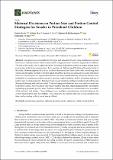Files in this item
Maternal decisions on portion size and portion control strategies for snacks in preschool children
Item metadata
| dc.contributor.author | Reale , Sophie | |
| dc.contributor.author | Marr , Colette | |
| dc.contributor.author | Cecil, Joanne Elizabeth | |
| dc.contributor.author | Hetherington, Marion | |
| dc.contributor.author | Caton, Sam | |
| dc.date.accessioned | 2019-12-09T11:30:04Z | |
| dc.date.available | 2019-12-09T11:30:04Z | |
| dc.date.issued | 2019-12-09 | |
| dc.identifier | 262928910 | |
| dc.identifier | 88920190-5249-4c34-a0a8-4cb8e200bede | |
| dc.identifier | 85076488391 | |
| dc.identifier | 000506917800171 | |
| dc.identifier.citation | Reale , S , Marr , C , Cecil , J E , Hetherington , M & Caton , S 2019 , ' Maternal decisions on portion size and portion control strategies for snacks in preschool children ' , Nutrients , vol. 11 , no. 12 , 3009 . https://doi.org/10.3390/nu11123009 | en |
| dc.identifier.issn | 2072-6643 | |
| dc.identifier.other | ORCID: /0000-0003-4779-6037/work/66070497 | |
| dc.identifier.uri | https://hdl.handle.net/10023/19098 | |
| dc.description | Funding: UK BBSRC BB/M027384/1. | en |
| dc.description.abstract | Caregivers are responsible for the type and amount of food young children are served. However, it remains unclear what considerations caregivers make when serving snacks to children. The aim of the study was to explore mothers’ decisions and portion control strategies during snack preparation in the home environment. Forty mothers of children aged 24–48 months participated in the study. Mothers prepared five snack foods for themselves and their child whilst verbalizing their actions and thoughts. Mothers were then asked about their portion size decisions in a semi-structured interview. Transcripts were imported into NVivo and analyzed thematically. Three key themes were identified: (1) portion size considerations, (2) portion control methods, and (3) awareness and use of portion size recommendations. Transient, food-related situational influences influenced mothers and disrupted planning and portion control. Food packaging and dishware size were used as visual cues for portion control; however, these vary widely in their size, thus emphasizing mothers’ uncertainty regarding appropriate portion sizes. Mothers called for portion size information to be accessible, child-centered, and simple. These findings reveal multiple considerations when deciding on the correct snack portion sizes for children. These decisions are complex and vary across situations and time, and according to the types of snacks offered. | |
| dc.format.extent | 279865 | |
| dc.language.iso | eng | |
| dc.relation.ispartof | Nutrients | en |
| dc.subject | Portion size | en |
| dc.subject | Preschool children | en |
| dc.subject | Mothers | en |
| dc.subject | Qualitative | en |
| dc.subject | Think-aloud method | en |
| dc.subject | RA0421 Public health. Hygiene. Preventive Medicine | en |
| dc.subject | RJ Pediatrics | en |
| dc.subject | NDAS | en |
| dc.subject | SDG 3 - Good Health and Well-being | en |
| dc.subject.lcc | RA0421 | en |
| dc.subject.lcc | RJ | en |
| dc.title | Maternal decisions on portion size and portion control strategies for snacks in preschool children | en |
| dc.type | Journal article | en |
| dc.contributor.sponsor | BBSRC | en |
| dc.contributor.institution | University of St Andrews. School of Medicine | en |
| dc.contributor.institution | University of St Andrews. Population and Behavioural Science Division | en |
| dc.contributor.institution | University of St Andrews. Health Psychology | en |
| dc.identifier.doi | 10.3390/nu11123009 | |
| dc.description.status | Peer reviewed | en |
| dc.identifier.grantnumber | BB/M027384/1 | en |
This item appears in the following Collection(s)
Items in the St Andrews Research Repository are protected by copyright, with all rights reserved, unless otherwise indicated.

